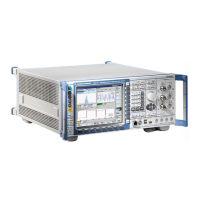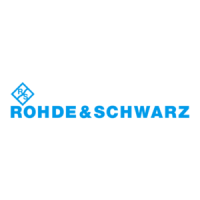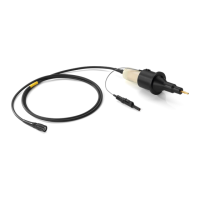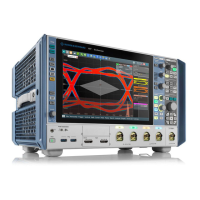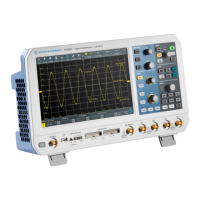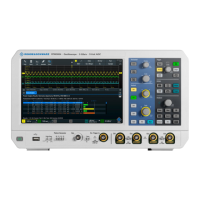CMU Structure and Syntax of Device Messages
1100.4903.12 5.9 E-8
Example:
TRIGger:SOURce EXTern
TRIG:SOUR EXT
Note:
The short form is marked by upper-case letters, the long form cor-
responds to the complete word. Upper-case and lower-case nota-
tion only serves to distinguish the two forms in the manual, the
instrument itself does not distinguish upper-case and lower-case
letters.
Parameters:
Parameters must be separated from the header by a "white space". If several pa-
rameters are specified in a command, they are separated by a comma ",". For a
description of the types of parameter, refer to section Parameters on page 5.10.
Example:
CONFigure:POWer:CONTrol SCALar,100
This command defines the type of measured values in a power measurement and
the number of samples/bursts forming a statistics cycle.
Numeric suffix:
If a device features several functions or features of the same kind, e.g. several
inputs, the desired function can be selected by a suffix added to the command.
Entries without suffix are interpreted like entries with the suffix 1.
Example:
SOURce:CORRection:LOSS:INPut2 10dB
This command defines the external attenuation at the input connector RF 2
Structure of a Command Line
A command line may consist of one or several commands. It is terminated by a <New Line>, a <New
Line> with EOI or an EOI together with the last data byte. Visual BASIC automatically produces an EOI
together with the last data byte.
Several commands in a command line must be separated by a semicolon ";". If the next command be-
longs to a different command system, the semicolon is followed by a colon.
Example:
CALL IBWRT(device%, "TRIGger:SOURce EXTern;:FETch:POWer:STATus?")
This command line contains two commands. The first command belongs to the TRIGger
system and defines the trigger source (external trigger). The second command belongs to
the FETCh system and returns the status of the power measurement.
If the successive commands belong to the same system, having one or several levels in common, the
command line can be abbreviated. To this end, the second command after the semicolon starts with the
level that lies below the common levels (see also Fig. 5.1). The colon following the semicolon must be
omitted in this case.
Example:
CALL IBWRT(device%, "TRIG:SOUR EXT;:TRIG:THR LOW")
This command line is represented in its full length and contains two commands separated
from each other by the semicolon. Both commands are part of the TRIGger command
system, i.e. they have one level in common.
When abbreviating the command line, the second command begins with the level below
TRIG. The colon after the semicolon is omitted.
The abbreviated form of the command line reads as follows:
CALL IBWRT(device%, "TRIG:
SOUR EXT;THR LOW")
However, a new command line always begins with the complete path.
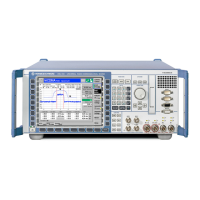
